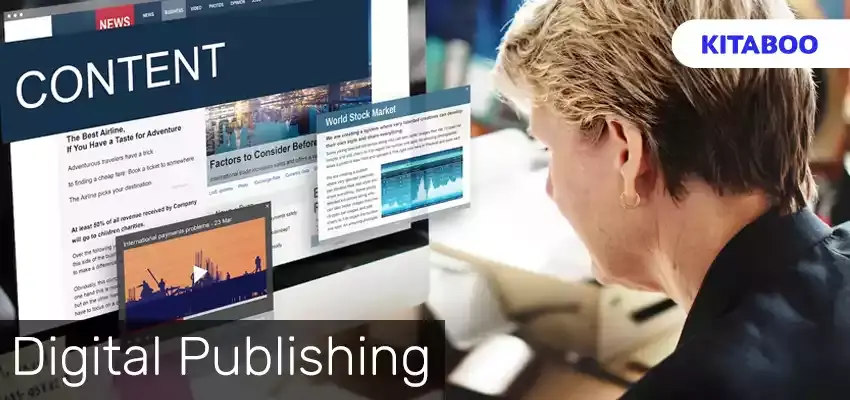
Digital Publishing in 2024: Embracing the Future of Reading
Summarize this blog with your favorite AI:
In this era, technology has entered almost every sphere of life. Whether it’s the corporate world, the academic arena, or the field of content creation, digital publishing is the perfect example of the modern use of technology, which has transformed the future of reading.
With digital publishing, your content comes alive on multiple screens in several formats and is circulated across various corners of the world. So, if you want to enjoy the benefits of innovative and accessible digital publishing, you need to embrace a multi-platform approach and prioritize responsive design.
KITABOO, one of the leading textbook platforms, offers an impactful and feature-rich experience of digital publishing. The platform comes with a user-friendly interface, supporting content adaptation for various devices and screen sizes.
Table of Contents:
I. Understanding Digital Publishing and its Key Features
- Convenient, Flexible, and Accessible Anytime, Anywhere
- Integrates Immersive and Interactive Content
- Promotes Instant Updating and Distribution
- Offers Self-Publishing Opportunities
- Utilizes Data Analytics for Personalization
- Reduces the Environmental Impact
- Is Cost-Effective
II. Step-by-Step Process of Digital Publishing
- Step 1: Content Creation
- Step 2: Choose the Best Digital Publishing Software
- Step 3: Enhance Interactivity and Compatibility
- Step 4: Pick the Right Distribution Platforms
- Step 5: Monitor Analytics
III. Conclusion
Understanding Digital Publishing and its Key Features
Rather than depending on traditional printed formats for books, documents, and written content, digital publishing has a profound impact on the future of reading, which leverages electronic platforms such as eBooks, audiobooks, online magazines, etc.
Below are some of the major features of digital publishing worth exploring in 2024:
Convenient, Flexible, and Accessible Anytime, Anywhere
Digital publishing offers unparalleled convenience, flexibility, and availability and can carry an entire library and make it accessible anytime, anywhere, with just a few taps. It enables reading on various devices, where users can get any content, whether business-related, educational, or informational, at their fingertips.
Integrates Immersive and Interactive Content
Digital publishing incorporates various multimedia elements such as videos, infographics, audio clips, charts and graphs, animations, hyperlinks, and interactive graphics. This offers modern readers a more engaging experience.
So, if you are looking to captivate your audience and enhance their reading experience, integrating immersive and interactive content is crucial in the realm of digital publishing.
Promotes Instant Updating and Distribution
Unlike print books, for which newer versions have to be reprinted, recirculated, and remarketed, digital publishing can be modified, updated, and distributed swiftly.
Content creators can make several revisions and corrections or add content in real time, ensuring that readers have up-to-date versions and access to fresh and relevant material.
Offers Self-Publishing Opportunities
Digital publishing empowers authors, publishers, writers, and content creators to independently bring their work in front of a global audience by using various self-publishing platforms. You only have to upload and distribute your content, which also eliminates geographical barriers. This gives authors control over their creative work.
Utilizes Data Analytics for Personalization
Digital publishing leverages the power of data analytics to enhance personalization and gain valuable insights into individual tastes. This can be done through book recommendations, social media statistics, and by creating a stronger connection between the audience and the content.
Reduces the Environmental Impact
Digital publishing does not require paper, ink, and transportation, which ultimately minimizes deforestation, reduces energy consumption, mitigates carbon emissions, and decreases the demand for physical storage space. It contributes to a more sustainable and eco-friendly future, thus reducing the environmental impact of the publishing industry.
Cost-Effective
Digital publishing significantly reduces expenses by eliminating upfront printing and storage expenditures, affordable production processes, the absence of intermediaries, and negligible traditional publishing fees. Content creators and publishers no longer need to bear the logistical expenses of shipping physical copies, making it a financially viable option for authors.
Step-by-Step Process of Digital Publishing
Here’s a step-by-step guide to the digital publishing process:
Step 1: Content Creation
The first crucial step in the process of digital publishing is the generation and development of relevant content. Authors, content creators, and publishers must focus on the following:
- Crafting engaging, designing visually appealing layouts, and incorporating multimedia elements.
- Enhancing the overall reader experience by considering the specific requirements of digital platforms
- Concentrating on formatting requirements for various devices and framing SEO-optimized headings, meta information, and table of contents.
- Incorporating relevant keywords and crafting compelling descriptions will ensure that the final product appears in search engine results, attracting a wider audience.
- Ensuring that the content is well-structured, well-aligned with the reader’s demands and latest market trends, and of extremely high quality.
- Choosing the right format is critical, which includes ePub for ebooks, MP3 for audiobooks, and various multimedia formats for interactive content.
Step 2: Choose the Best Digital Publishing Software
After determining the appropriate format for the content, the next crucial step is selecting the best digital publishing software. The top factors to consider while finalizing the best digital publishing software are:
- User-friendly interface with various immersive, multimedia, and interactive features, along with compatibility with the selected format.
- It should possess a range of capabilities for content conversion and customization.
- The right software should also contribute to the overall quality, sharing capabilities, distribution functions, consumer service provision, and functionality of the final product.
- Lastly, you must consider affordability, consumer ratings, and feedback before settling for the best software.
KITABOO is one of the leading DRM-protected digital textbook platforms that comes with a user-friendly interface and enables publishers to create engaging and interactive digital content seamlessly.
Step 3: Enhance Interactivity and Compatibility
The next step is to ensure compatibility of the content with various devices. After incorporating multimedia elements, content creators must optimize the publication for compatibility across different devices and platforms. It is important to test compatibility and address any potential issues related to responsiveness, layout, or functionality.
Step 4: Pick the Right Distribution Platforms
After enhancing the content and ensuring its compatibility, it is important to confirm that the content is circulated across common distribution platforms. Here are some things to consider:
- For a global reach, it is crucial to address the specific requirements of each platform and look into user reach, revenue models, and promotional opportunities.
- Here, data analytics, marketing strategies, promotional opportunities, and opting for the best digital publication are imperative to reach a global audience and gain recognition.
- It is equally important to develop a comprehensive marketing strategy to promote their digital publication effectively. Authors and publishers can utilize various online channels, such as social media, email marketing, and author websites, to enhance visibility. Additionally, you can run promotional campaigns, offer discounts, or collaborate with influencers.
- Engagement and consumer interaction are also significant. Authors must respond to reviews, gather feedback, join online content-related communities, and create interactive platforms for discussions or Q&A sessions.
Step 5: Monitor Analytics
Monitoring analytics provides valuable insights into reader behavior, preferences, and engagement patterns. Content creators can monitor consumer feedback and behavior to understand how their audience interacts with the content. Analytics includes metrics such as user demographics and interaction with multimedia elements, as well as an assessment to judge the effectiveness of promotional campaigns and areas for improvement.
Conclusion
When it comes to digital publishing, content creators, publishers, and consumers need to make sure they are aligned to foster a sustainable, ethical, and engaging digital ecosystem.
KITABOO, as a digital textbook platform, exemplifies the potential for transformative learning experiences. By leveraging technology, it extends educational content beyond the limitations of traditional textbooks and offers interactive features, multimedia elements, and personalized learning pathways.
Write to us at contact@kitaboo.com to learn more!
Discover how a mobile-first training platform can help your organization.
KITABOO is a cloud-based platform to create, deliver & track mobile-first interactive training content.


![Top 5 Free Publishing Sites for Independent Publishing [2026]](https://kitaboo.com/wp-content/uploads/2025/09/Top-5-Free-Publishing-Sites-for-Independent-Publishing-2026-420x235.webp)
